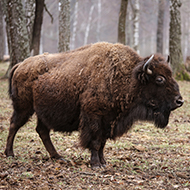
Conservation efforts ongoing as 31 species declared extinct
The International Union for Conservation of Nature (IUCN) has announced that the European bison has moved from Vulnerable to Near Threatened status in the latest update to the IUCN Red List of Threatened Species.
The European bison survived only in captivity throughout the early 20th Century, being reintroduced into the wild in the 1950s. Thanks to long-term conservation management, the wild population of the European bison has grown from 1,800 in 2003 to 6,200 in 2019.
According to IUCN, there are currently 47 free-ranging European bison herds, but only eight of them are large enough to be genetically viable in the long term.
Dr Rafał Kowalczyk, co-author of the new assessment and member of the IUCN SSC Bison Specialist Group said: “Historically, European bison were reintroduced mostly to forest habitats, where they don’t find enough food in winter.
“However, when they move out of the forest into agricultural areas, they often find themselves in conflict with people. To reduce the conflict risk and the bison’s dependence on supplementary feeding, it will be important to create protected areas that include open meadows for them to graze.”
The latest update also saw 31 species move into the Extinct category and all of the planet's freshwater dolphin species are now threatened with extinction.
IUCN director general Dr Bruno Oberle said: “The European bison and 25 other species recoveries documented in today’s IUCN Red List update demonstrate the power of conservation.
“Yet the growing list of Extinct species is a stark reminder that conservation efforts must urgently expand. To tackle global threats such as unsustainable fisheries, land clearing for agriculture, and invasive species, conservation needs to happen around the world and be incorporated into all sectors of the economy.”



 BSAVA is to partner with BVA Live (11-12 June 2026) to champion clinical research.
BSAVA is to partner with BVA Live (11-12 June 2026) to champion clinical research.